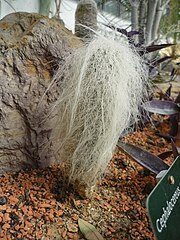Felted
This article may be too technical for most readers to understand. (December 2022) |
This article cites its page references. (December 2022) ) |

A felted material is a hairy or filamentous (hairy-like) fibre that is densely packed or tangled, forming felt or felt-like structures.
Advantages of felted tissue
The
Zoology
Mammals

Although truly felted hair on healthy mammals is unusual, many animals, especially in seasonally cold or wet climates or environments, have a so-called undercoat of
The ground-dwelling mice species of the genus
Birds

Weaver birds of the family
Invertebrates


The
Burying beetles of genus Nicrophorus are known for stripping the fur or feathers from the carcasses that they prepare for their young, then using the material to line and reinforce the crypt that they dig.[12] It is unclear if this habit is incidental or how important it is to the species. French naturalist and entomologist Jean-Henri Fabre demonstrated that the species he investigated did not depend on feathered or hairy food items and were capable of using reptiles, amphibians and fish.[13]
Carder bees of family Megachilidae build their nests using fibre collected from arachnoid plants, and possibly fibre from other sources such as animal wool.[14]

Spider egg cases are partly or largely felted silk. The lids of various species of trapdoor spider burrows vary in their construction, but they are largely of earth and similar material reinforced with partly felted silk.[citation needed]
Botany

In botany, felted is defined as "matted with intertwined hairs".[15] A felted covering is protective against grazing or browsing, wind, windblown sand, ultraviolet radiation, drought, and desiccation.[citation needed] An example is Cephalocereus senilis (old man cactus), which has radial spines that grow into a tangled coating of white hair, concealing the green tissue and the spines. The felt forms a protection against intense radiation, wind, frost, and herbivores.[16] The woolly masses of fibres on such cacti have been used as stuffing for pillows.[17]
Mycology

Most fungal tissue is filamentous, predisposing it to grow into tangles that lend themselves to felting. Whereas vascular plants seldom have cells that grow into forms that can form massive tangles, fungi hardly can form tissues at all except by tangling and felting their hyphal filaments.[clarify] Most mushroom tissue, including cords and membranes, is formed of anastomosed and felted hyphae. The spots on the caps of Amanita muscaria consist of felted patches of remnant tissue from the volva.[18]
References
- ^ a b Gray, Henry (1918). Anatomy of the Human Body. Revised by Warren H. Lewis (20th ed.). Philadelphia: Lea & Febiger. Retrieved 27 December 2022 – via Internet Archive.
- ISBN 978-0140277333.
- ISBN 978-0306812835.
- ISBN 0-08-021209-3.
- ISBN 978-0801886959.
- ISBN 978-9546423139.
- ISBN 978-0299021504.
- ^ Rennie, James (1845). "Chapter VIII". Natural History of Birds: Their Aarchitecture Habits and Faculties. New York: Harper – via Internet Archive.
- ISBN 9780620340533.
- ISBN 978-1868727131.
- ISBN 978-0674021631.
- ISBN 978-0761472698.
- ^ Fabre, Jean-Henri (1919). The glow-worm and other beetles. Translated by Alexander Teixeira de Mattos. New York: Dodd, Mead and Company – via Internet Archive.
- ^ Fabre, Jean-Henri (1915). The Bramble-bees and others. Translated by Alexander Teixeira de Mattos. New York: Dodd, Mead and Company – via Internet Archive.
- ^ Jackson, Benjamin Daydon (1928). A Glossary of Botanic Terms with their Derivation and Accent (4th ed.). London: Gerald Duckworth & Co. Retrieved 27 December 2022 – via Biodiversity Heritage Library.
- PMID 16820405.
- ISBN 978-0896725317.
- ISBN 978-0521186957.
